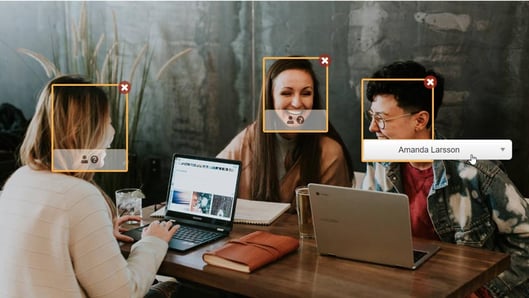Digital Rights Management, often shortened DRM, is central in protecting an organizations' digital assets from being used or shared by an unauthorized user. Regardless the industry of your business, data protection is always a hot topic and need to be taken seriously to secure customer and internal data. This goes for all users involved in managing, creating and distributing digital assets.
For a company using a digital asset management (DAM) system like QBank a rights management process involves controlling access, managing consent and limiting availability to authorized users. With thousands of assets this process could be both complex and time-consuming. Let us break down why you need to manage digital rights, what the challenges are and how you could benefit from using a DAM software with an automated digital rights management process in mind.
Contents:
- Why you need a process to manage digital rights on your assets
- Challenges of Digital Rights Management
- Benefits of a digital rights process in a DAM system
- QBank's consent feature a big part in managing digital rights
Why you need a process to manage digital rights on your assets
Sharing images and videos are easier than ever. With data protection regulations and copyright laws you as a digital rights manager need to keep track on when and where a person's portrait or art work is published. Processes for consent, user rights and digital rights must exist in order to avoid penalties and law suits.
If you have a DAM system for all your valuable digital assets you need to ensure only authorized users got access and that published material has all the consent needed from persons (e.g. employees or customers) and external creators. You don't need a separate digital rights management software for keeping your assets secure.
Challenges of Digital Rights Management
From a company point of view the biggest challenge of digital rights is managing consent at a bigger scale. This includes both the part of obtaining and withdrawal of consent for digital assets.
A lot of time is spent on sending out consent forms and manually connecting these forms with the right assets. With thousands of digital assets it is hard to keep track on where and by whom the digital asset is being used and if consent is valid or not. A consent agreement or permission to use copyrighted material could also be time-limited and should therefor not be used after a certain date.
Another big challenge is not having control of user rights and media access. By not having control of user access it could be devastating for a company when a photo is used on a website page or a campaign, without consent from a person or a photographer.
Benefits of a digital rights process in a DAM system
Why is DAM relevant when talking about digital rights? As you may already know, digital assets could be anything from a photo of employees at an event to a campaign banner where an external photographer have taken all the pictures. In order to use these assets you would have to comply with local privacy regulations (e.g. GDPR) and make sure you have all the consent and permissions obtained and cared for.
An automated digital rights management process integrated with an advanced DAM system enable you to:
1. Automating the consent process
Forget about handing out consent forms to be signed, scanned and sent back. In QBank you can send an automatic e-mail asking for consent linked to one or many assets. It could be a one-time agreement or just for a specific campaign. Each signed consent is directly related to the assets and is visible on the asset detail view.
In addition to consent an expiration date can be set. When this date is getting closer you will be notified about the upcoming expiration and take action to archive or renew the consent. This could come in handy when a person has left the company and all related assets where the person is depicted needs to be deleted.
2. Ensuring distribution is compliant
A DRM process within DAM ensures that distribution of digital assets is compliant and that they wont be altered in inaccurate formats or being used in wrong distribution channels (e.g. websites or geographical sites). In QBank there is an AI feature showing if a certain asset has been published and used externally.
Together with the user rights management you can limit or restrict what users can do with the assets. Should users be able to edit or save content? Edit formats or download assets? Maybe artwork should be watermarked to ensure digital artwork remain copyrighted.
3. Controlling user rights and media access
Controlling user rights in your DAM system will make sure only specific users or publishing channels (CMS integration, social media, intranet etc.) can access an asset. This will prevent assets from being used in wrong context. For example a copyright protected picture is only allowed to be used in the European market and should not be visible to a user in the US Team.
Having this control will make sure digital rights and consent regulations are being followed.
QBank's consent feature a big part in managing digital rights
With the feature 'consent process' in your QBank you could save both time and money by making the rights and consent management completely digital and automated.
Interested to know more about digital rights management from a DAM perspective? Watch our on-demand webinar.
